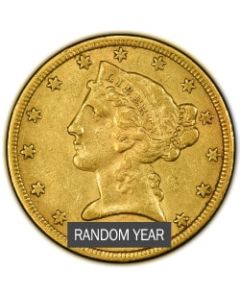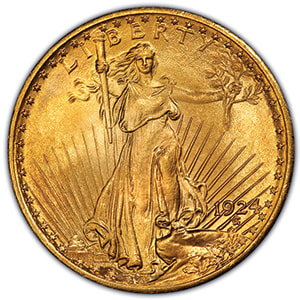Buy Pre-1933 US Mint Gold Coins
The United States Mint started production of gold coins in 1795, two years after the passage of the Coinage Act. The Mint in Philadelphia had a slow start and the first couple years were focused on making copper and silver coins for the mill, cent, dime and dollar denominations.
Initially, gold coinage involved the US Eagle ($10), the Half Eagle ($5) and the Quarter Eagle ($2,50). The Double Eagle ($20) was later introduced, in 1850. At the time, the face value attributed to the coins was actually suitable for the gold content used in their minting.
The amount of gold was proportional to their face value as well. That means the The US Eagle had double the amount of gold as the Half Eagle, and four times that of the Quarter Eagle.
However, with time and inflation, especially the economic collapse of 1929 and the government measures put in place during President Franklin D. Roosevelt's term, the precious metal content within these American gold coins began to outweigh their face value drastically. So, in order to prevent people from melting down coins, President Roosevelt introduced a new model of fiat currency, setting aside the previous gold-based standard for the first time in US history. His office would then pass the Executive Order 6102, prohibiting most private gold ownership and demanding a confiscation of any gold coins in circulation in exchange for paper-money.
All confiscated gold was melted down by the government and used to feed the federal gold reserve. The fact that these coins survived the confiscation act and are still on the market today is a testament to their historic and numismatic value. They have been in circulation during times of prosperity and crisis, through war and peace and are an essential item to any investment portfolio diversification plan and/or respected coin collection.
Seize the chance to be the owner of part of American coinage history and buy your pre 1933 Gold Coins from us here at SD Bullion.
Denominations, Designs and Gold Content
As mentioned above, gold coinage began at the US Mint in 1795 with the Eagle and Half Eagle Production of the Quarter Eagle would start the following year. With the Gold Rush happening all across the nation, especially in California and the West Coast in general around 1850, there was a tremendous increase in gold supply for the Mint and Congress approved three new denominations using gold: the Gold Dollar, the Three-Dollar Gold Coin and the Double Eagle.
Different designs were used over the years and some of them still serve as an inspiration for modern day bullion coins, like the American Golden Eagle program.
US EAGLE
The Eagle was the United States $10 gold coin denomination issued until 1933. It was initially struck with 33.0 mm diameters and 22k gold (91,667% pure gold, also known as English crown gold).
In 1834, in order to avoid melting and exportation of U.S. gold coins, the amount of gold used was reduced from .9167 to .8992 fineness (21.58 kt). However, it was later increased again to 90% in 1838, when all silver content was removed from the alloy, with copper being used in the remaining 10%, which resulted in 0.48375 troy ounces of gold.
The $10 gold piece had a 34-year gap in production, from 1804 to 1838.
The following designs were used for the US Eagle:
- From 1795 to 1804 - Turban Head;
- From 1838 to 1907 - Liberty Head, also known as Coronet;
- From 1907 to 1933 - Indian Head.
THE HALF EAGLE
The Half Eagle was the United States $5 gold piece and was struck until 1929. It was first produced with 25.0 mm diameter, but was reduced a few times, to 23.8 mm in 1829, to 22.5 mm in 1834 and again, for the final time, in 1866 to 21.6 mm.
Its gold composition went through the same changes as the Eagle, so in 1838, when 90% gold and 10% copper started being used, its gold content was of 0.24187, exactly half that of the Eagle.
The Half Eagle had the designs below over the years:
- From 1795 to 1807 - Turban Head;
- From 1807 to 1812 - Draped Bust;
- From 1813 to 1834 - Capped Head;
- From 1834 to 1838 - Classic Head;
- From 1839 to 1907 - Liberty Head;
- From 1908 to 1916, and again in 1929 - Indian Head
THE QUARTER EAGLE
The $2.50 gold coin. It was produced, on and off, over the years until its final issue in 1929. It was also first struck with .9967 fineness, later changed to .8992 with the final modification in 1837 to 90% gold and 10% copper. The Quarter Eagle started with 20.0 mm in diameter, and it was reduced to 18.5 mm in 1821, to 18.2 mm in 1829 and to 18.00 mm from 1840 and forth.
It contained precisely 0.12094 troy ounces of gold, one quarter the amount of the Eagle.
Designs for the Quarter Eagle:
- From 1796 to 1807 - Turban Head;
- In 1808, and then again from 1821 to 1834 - Capped Bust;
- From 1834 to 1839 - Classic Head;
- From 1840 to 1907 - Liberty Head (Coronet);
- From 1908 to 1929 - Indian Head.
THE DOUBLE EAGLE
The Gold Double Eagle was the $20 variation of the Eagle. It was first introduced in 1850 after gold supply increased exponentially due to the California Gold Rush. Unlike the other Eagle denominations, the Double Eagle was always minted with 90% gold and 10% copper (as that was already the standard at the time of its inception). It was also always produced with a 34.0 mm diameter.
The Double Eagle is famous for its iconic Saint-Gaudens design, where it features Lady Liberty strolling with a lit torch on the right hand and an olive branch on the left, with the rising sun on Her back on the coin's obverse. This design was named after its sculptor, Augustus Saint-Gaudens and was revitalized by the modern day American Gold Eagle bullion coin.
Double Eagle designs:
- From 1850 to 1907 - Liberty Head (Coronet);
- From 1908 to 1933 - Saint-Gaudens.
THE GOLD DOLLAR
The Gold Dollar denomination was the one-dollar piece minted from 1849 to 1889. It was struck using 90% gold and 10% copper and contained 0.04837 troy ounces of gold (one tenth that of the Eagle). It had three different designs during the years of minting, all three created by Chief Engraver of the time, James B. Longacre.
It was initially created with 12.7 mm in diameter, but was later increased to 14.3 mm.
The designs for the Gold Dollar were:
- From 1849 to 1854 - Liberty Head wearing a coronet;
- From 1854 to 1856 - Liberty Head portrayed as an Indian Princess;
- From 1856 to 1889 - Liberty Head known as the Large Head design;
THE THREE-DOLLAR PIECE
Mintage for the Three-Dollar gold piece began in 1854 and continued regularly until 1889.
The $3 face value coin had a diameter of 20.5 mm and contained .1451 troy ounces of gold.
The designs for this piece were taken from the Gold Dollar, depicting the Liberty bust wearing a Native American Headdress (sometimes called the Indian Princess).
Why invest in pre 1933 coins?
Investing in Pre 33 gold coins can be a great way to expand your gold bullion holdings with these historic and numismatic items. SD Bullion guarantees they are original US Mint products. You will find them in our stocks in a variety of conditions, including certified coins.
Gold bullion investors and coin collectors alike have much to gain from purchasing a more rare gold coin such as these.
If you have any questions regarding these products, or any other bullion or numismatic coin, make sure to contact our customer support at 1(800)294-8732 or through our Live Web Chat feature. We are also available via e-mail at sales@sdbullion.com outside of office hours.













